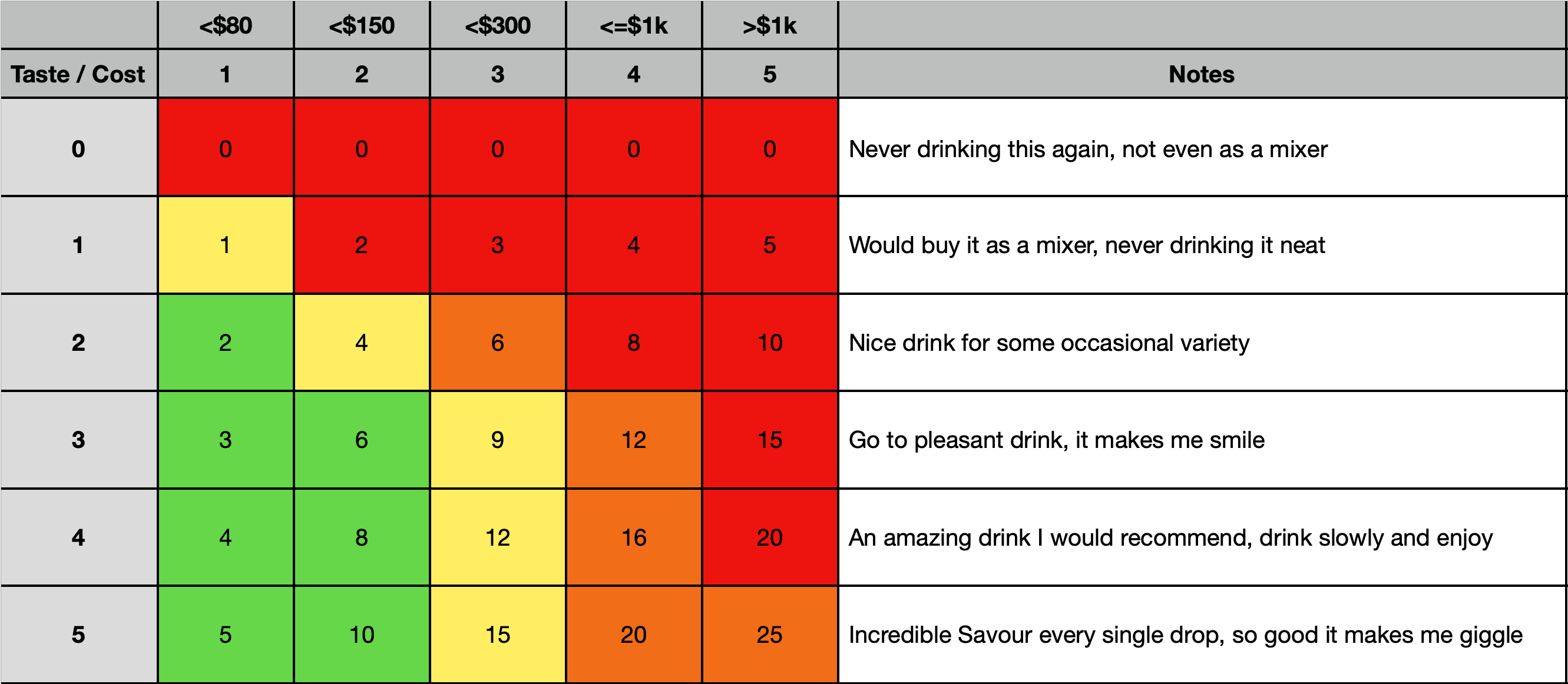Whisky: The Whisky Whiskey Rating System
21 October, 2024I’ve been reading and listening to lots and lots of Whisky Reviews in the past few months and I’ve come to the conclusion that, since taste is highly subjective, all ratings scales and Whisky rankings against them are unique to the individual. That said, there are good and bad scales that don’t help and can lead to skewed results.
I’ve decided to have a crack at my own, because, of course I have…
I propose to rank all of the Whiskies that I try against two Axes: the Columns represent a quantitative measure: the current amount (at time of review) a standard 700mL bottle costs. For bottles that aren’t available in this size (eg. many Australian Whiskies are sold in 500mL bottles) then the costs will be linearly re-scaled. Cost will also exclude sale pricing and will be based on recommended retail and will be in Australian Dollars because…well…I’m Australian. Prices overseas will vary based import duties, local taxes and currency conversion factors so you kilometerage may vary.
I understand that prices will vary over time due to supply and demand, manufacturer economies of scale and desirability in the market. As these things change, so too will their position if/when I revisit a review. Price bracketing was guided by the quantity of bottles available that fell into those pricing categories. To be clear you can get a Single Malt Scotch for under $80 but there aren’t many, and those that are, generally aren’t going to set your world on fire. There are passable Blended Whiskies however that can be great everyday sippers.
The second scale is the inevitable Qualitative scale of Taste (which is subjective) about how much I personally would desire drinking the Whisky at some point again in the future. For this I propose a scale of 1 to 5 which is intentionally not too granular but groups together the most common positions I’ve taken when trying different Whiskies. I also decided it’s important to add a ZERO (0) row since there are ones I’ve tried, that I will simply never drink…again.
This leads to a simple table below:

Finally I’m going to simplify the outcome with a colour recommendation. I’ve coloured each box with a slant against people that have loads of disposable income to buy expensive alcohol. Generally speaking, if it’s more than $300 for a bottle, it needs be a truly impressive drink to consider investing in one. Whereas a lower scored 2, a nice drink for some occasional variety, if it’s less than $80 and you’re into Whisky, then it’s Green: Always keep stock of these on hand. Of course your evaluation of how much you’re willing to spend on a nice Whisky will vary but for me, at least for now, is my guide.

I have intentionally NOT split out Legs, Finish, Palette or Nose on their own scales and I’ve intentionally kept the two axes separate since a great nose but a bad finish could end up with a score that matches a bad nose but a great finish. To me the assessment is overall, which includes all of those factors. Like a good Whisky, the qualitative assessment needs to be balanced.
But in the end it’s still all subjective. Hopefully this scoring system will be a good sanity check for myself in the first instance and for others as well that are following along at home when trying to decide which bottle they should or should NOT buy.
Good luck.